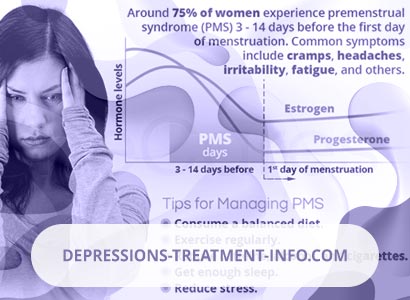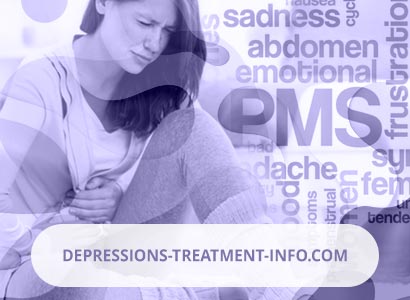Premenstrual Syndrome
It is very common to observe premenstrual syndrome (PMS) in many menstruating women. PMS is the emotional and physical symptoms such as bloating, abdominal pain, fatigue, muscle or joint pain, headache & backache, which begins a week before the start of the regular period. But in some women, these recurring symptoms are very severe and deliberate and are often confused by PMS.
But if someone is experiencing the severe form of these symptoms which disturbs their routine activities of life, then it is known as a premenstrual dysphoric disorder (PMDD) and sometimes it is a serious condition. It is therefore important to know the difference between PMS and its severe form, PMDD.
This article covers all the aspects regarding premenstrual dysphoric syndrome such as what is PMDD, its causes, symptoms, and treatments.
Overview:
Premenstrual Dysphoric Disorder (PMDD), is a severe, disabling form of premenstrual syndrome (PMS) in menstruating women. Every 3 out of 4 menstruating women experiences some signs of premenstrual syndrome (PMS) but around 3-8% of menstruating women suffer from Premenstrual Dysphoric Disorder (PMDD).

In 2013, PMDD was listed among the depressive disorders in the Diagnostic and Statistical Manual of Mental Disorders due to its behavioral & somatic symptoms. The exact causes & reasons for PMDD are still not clear and the research is still active but treatment for PMDD is available.
Although the symptoms and signs of PMDD are similar to that of PMS the emotional & physical symptoms of PMDD are more deliberate & severe and interferes with the daily life routine. The signs and symptoms of PMDD recur during the luteal phase of the menstruation cycle and hence has a predictable pattern.
Causes of Premenstrual Dysphoric Disorder (PMDD):
The exact pathogenesis of the premenstrual dysphoric disorder is not known yet but the researchers are conducting research on its causes. However, it is believed that PMDD is a cause or an abnormal reaction of hormonal changes during the menstrual cycle.
So far the studies conducted on the causes of PMDD have shown that Premenstrual Dysphoric disorder is directly associated with the low serotonin level. Serotonin is a brain chemical which regulates and aids nervous signals.
Brain cells require serotonin to control certain behavioral patterns such as mood, sleep, attention, and pain. Hence, the hormonal changes during the menstrual cycle lower the level of serotonin which starts the symptoms of the premenstrual dysphoric disorder.
In some women, premenstrual dysphoric disorder is the result of depression or panic disorder. Moreover, women who have or had other gynecological conditions such as fibroids, endometriosis, menopause, or hormone problems also experience premenstrual dysphoric disorder.
It is often believed that sometimes premenstrual dysphoric disorder is a conseuqnece of change in diet, or strict dieting or sudden weight gain or loss. It's only a possibility and no such evidence regarding this statement is available so far.
What are the Symptoms & When These Show Up?
There is a wide range of symptoms & signs of PMDD which are almost similar to those of PMS but these symptoms are more severe and celebrate. Normally the symptoms of premenstrual dysphoric disorder start a week before the period starts and lasts until a few days of the period cycle.
The symptoms are both physical and emotional.
Emotional Symptoms: There are a number of emotional symptoms which indicates the PMDD. These emotional symptoms have been listed below. Some of the symptoms are similar to those of PMS but more severe.
- Mood Swings
- Depression
- Hopelessness
- Intense Anger
- Conflict with others
- Tension
- Anxiety
- Irritability
- Loss of Interest in usual activities
- Loss of concentration
- Feeling out of control
Physical Symptoms: In addition to emotional symptoms, menstruating women also tend to experience physical symptoms a week before their period start. The list of physical symptoms of the premenstrual dysphoric disorder includes:
- Fatigue
- Sleep problems
- Loss or change in appetite
- Bloating
- Severe Cramps
- Breast tenderness
- Muscle & joint pain
- Headaches
- Nausea
- Hot flashes
Do You Need to See a Doctor?
Even though the premenstrual syndrome or symptoms are common among menstruating women, but it is important to consult a doctor regarding the symptoms of premenstrual dysphoric disorder because sometimes depression, panic disorder, fibroids, hormone problems, or endometriosis can cause the PMDD.
Therefore, if you experience the symptoms of PMDD, you must talk to your gynecologist about your conditions so she could rule out the possibility of depression, fibroids, and other medical or gynecological problems.
How Do You Know That You Have PMDD?
Due to the similarity between the symptoms of PMS and PMDD, it is difficult to differentiate whether its the regular PMS or premenstrual dysphoric disorder. Usually, doctors use the following measures to diagnose whether someone is experiencing PMDD or not.
The measure or factors to consider while diagnosing someone with the premenstrual dysphoric disorder includes:
- Showing or having at least any 5 of the symptoms (listed above) of the premenstrual dysphoric disorder.
- Whether the symptoms start 7 or 10 days before getting your period.
- Whether the signs & symptoms go a day or two after your period begins.
If the signs and symptoms which are listed above in this article does not improve or goes away after you start bleeding, then it’s an indication towards some other medical or gynecological condition and it's a sign that these symptoms are not caused by PMDD.
In this situation, you need to immediately consult your doctor to get a proper diagnosis and treatment.
Treatment or Medication for Premenstrual Dysphoric Disorder:
Treatment and medication for the premenstrual dysphoric disorder are available but in many cases, the symptoms can be relieved by using the same remedies & strategies used in premenstrual syndrome (PMS).
To treat or reduce the symptoms of premenstrual dysphoric disorder there are three ways:
- Common treatment strategies
- Medications
- Herbal Remedies

Common Treatment Strategies:
The common treatment strategies to reduce or treat the symptoms & effects of premenstrual dysphoric disorder are similar to those used for treating premenstrual syndrome. These treatments or remedies include:
- Balanced, and healthy diet.
- Regular exercise and walk.
- Stress management.
- Proper & sufficient intake of water.
- Intake of vitamin supplements.
- Relaxation therapy.
- Yoga & Meditation.
- Reflexology.
Medications:
In treating the premenstrual dysphoric disorder (PMDD), the doctors usually prescribe the same medicines which are used for treating depression, anxiety or other depressive disorders. Three most common types of medications used for treating the premenstrual dysphoric disorder are:
- Anti-depressants - Selective serotonin reuptake inhibitors
- Hormone Therapy - Birth control pills
- Anti-inflammatory medicines
- Pain Relievers - Aspirin, Ibuprofen
- Diuretics - Water pills used for fluid retention & bloating
Herbal Remedies:
Although there is no conclusive evidence about the effectiveness of herbal remedies for treating premenstrual dysphoric disorder, these herbs have no side-effects. Some women believe that certain herbs are beneficial in comforting the symptoms of PMDD.
These herbs include:
- Chasteberry - Chaste tree extract
- Evening primrose oil
- Black cohosh
- St. Jhon’s wort
Diet Can Also Help You With Premenstrual Syndrome & Premenstrual Dysphoric Disorder:
Our diet is the key factor in controlling the health of our body and proper functioning of its mechanism. A balanced and healthy diet provides our body essential nutrients and our body mechanisms continues without any disturbance. As we know that premenstrual dysphoric disorder might be caused by hormonal changes & nutrient imbalance, therefore, it is believed that by controlling and changing the diet, women who suffer from PMDD can control or reduce it.
A proper, balanced diet to control or reduce the effects of the premenstrual dysphoric disorder includes certain elements. The suggestions for a proper diet for treating premenstrual dysphoric disorder include the following:
- Add High-Quality Calcium Foods: Calcium and vitamin D enriched diet is very effective for lowering the symptoms of the premenstrual dysphoric disorder. To avoid the symptoms of premenstrual dysphoric disorder you must aim to take at least 3 servings of food & diet enriched with calcium. Calcium-rich food includes low-fat milk, yogurt, soy milk, cheese or fortified orange juice.
- Never skip your Break-fast.
- Do not skip your Lunch or dinner and make sure to take meals at a proper & regular time.
- Increase the use of whole grains, vegetables, lean proteins and fruits in your diet.
- Reduce the use of sugar.
- Avoid salty foods.
- Make sure to drink at least 8 glass of water daily.
- Reduce the consumption of alcohol.
 AU
AU UK
UK CA
CA DE
DE FR
FR IT
IT ES
ES



